A New Reliability Coefficient Using Betting Commitment Evidence Distance in Dempster–Shafer Evidence Theory for Uncertain Information Fusion
Abstract
:1. Introduction
2. Preliminaries
2.1. Dempster–Shafer Evidence Theory
2.2. The Distance between Betting Commitments of the BPAs
2.3. Management of Conflict Data
2.3.1. Murphy’s Method: Average Values of BPA
2.3.2. Wang et al. Method: Conflict Management with Base Belief Function
3. A New Evidence Reliability Coefficient
3.1. The Proposed Measure
3.2. Numerical Examples of Using New Evidence Reliability Coefficient
4. Application
- Step 1
- Uncertain information modeling using basic probability assignment.Uncertain information modeling using basic probability assignment is the first step of applying D-S evidence theory. There are many methods for BPA generation [67].
- Step 2
- Evidence measuring with the new evidence reliability coefficient.
- Step 3
- Evidence modification based on the uncertainty measure result.
- Step 4
- Evidence combination with Dempster combination rule.The Dempster combination rule is applied for evidence fusion after evidence modification.
- Step 5
- Decision-making based on information fusion.For practical applications such as classification and identification, the decision-making can be made after information fusion steps.
4.1. Experiment 1
4.2. Experiment 2
4.3. Analysis of Application Result
5. Discussion and Open Issue
6. Conclusions
Author Contributions
Funding
Data Availability Statement
Acknowledgments
Conflicts of Interest
References
- Jiroušek, R.; Shenoy, P.P. On properties of a new decomposable entropy of Dempster-Shafer belief functions. Int. J. Approx. Reason. 2020, 119, 260–279. [Google Scholar] [CrossRef]
- Song, Q.; Ni, Y.; Ralescu, D.A. The impact of lead-time uncertainty in product configuration. Int. J. Prod. Res. 2020, 1–23. [Google Scholar] [CrossRef]
- Zhou, T.; Zhang, X.; Droguett, E.L.; Mosleh, A. A generic physics-informed neural network-based framework for reliability assessment of multi-state systems. Reliab. Eng. Syst. Saf. 2023, 229, 108835. [Google Scholar] [CrossRef]
- Zhang, X.; Mahadevan, S. Ensemble machine learning models for aviation incident risk prediction. Decis. Support Syst. 2019, 116, 48–63. [Google Scholar] [CrossRef]
- Liu, Z.g.; Zhang, Z.; Liu, Y.; Dezert, J.; Pan, Q. A new pattern classification improvement method with local quality matrix based on K-NN. Knowl.-Based Syst. 2019, 164, 336–347. [Google Scholar] [CrossRef]
- Kang, B.; Chhipi-Shrestha, G.; Deng, Y.; Hewage, K.; Sadiq, R. Stable strategies analysis based on the utility of Z-number in the evolutionary games. Appl. Math. Comput. 2018, 324, 202–217. [Google Scholar] [CrossRef]
- Ho, W.; Ma, X. The state-of-the-art integrations and applications of the analytic hierarchy process. Eur. J. Oper. Res. 2018, 267, 399–414. [Google Scholar] [CrossRef]
- Yang, X.; Ni, Y. Size Relation of Uncertain Sets with Application to Clustering. J. Intell. Fuzzy Syst. 2020, 38, 4119–4125. [Google Scholar] [CrossRef]
- Fu, C.; Chang, W.; Xue, M.; Yang, S. Multiple criteria group decision making with belief distributions and distributed preference relations. Eur. J. Oper. Res. 2019, 273, 623–633. [Google Scholar] [CrossRef]
- Deng, X.; Jiang, W. An evidential axiomatic design approach for decision making using the evaluation of belief structure satisfaction to uncertain target values. Int. J. Intell. Syst. 2018, 33, 15–32. [Google Scholar] [CrossRef]
- Li, H.; Pan, D. Multi-photoelectric detection sensor target information recognition method based on DS data fusion. Sensors Actuators A Phys. 2017, 264, 117–122. [Google Scholar] [CrossRef]
- Xu, X.; Weng, X.; Xu, D.; Xu, H.; Hu, Y.; Li, J. Evidence updating with static and dynamical performance analyses for industrial alarm system design. ISA Trans. 2020, 99, 110–122. [Google Scholar] [CrossRef] [PubMed]
- Wu, G.Q.; Li, L.; Li, L.; Wu, X. Web news extraction via tag path feature fusion using ds theory. J. Comput. Sci. Technol. 2016, 31, 661–672. [Google Scholar] [CrossRef]
- Liu, Z.G.; Liu, Y.; Dezert, J.; Cuzzolin, F. Evidence Combination Based on Credal Belief Redistribution for Pattern Classification. IEEE Trans. Fuzzy Syst. 2020, 28, 618–631. [Google Scholar] [CrossRef] [Green Version]
- Liu, Z.G.; Huang, L.Q.; Zhou, K.; Denoeux, T. Combination of transferable classification with multisource domain adaptation based on evidential reasoning. IEEE Trans. Neural Netw. Learn. Syst. 2020, 32, 2015–2029. [Google Scholar] [CrossRef]
- Jiao, L.; Wang, F.; Liu, Z.G.; Pan, Q. TECM: Transfer learning-based evidential c-means clustering. Knowl.-Based Syst. 2022, 257, 109937. [Google Scholar] [CrossRef]
- Zhou, K.; Martin, A.; Pan, Q.; Liu, Z. SELP: Semi–supervised evidential label propagation algorithm for graph data clustering. Int. J. Approx. Reason. 2018, 92, 139–154. [Google Scholar] [CrossRef] [Green Version]
- Su, Z.g.; Denoeux, T. BPEC: Belief-peaks evidential clustering. IEEE Trans. Fuzzy Syst. 2018, 27, 111–123. [Google Scholar] [CrossRef]
- Jiao, L.; Yang, H.; Liu, Z.G.; Pan, Q. Interpretable fuzzy clustering using unsupervised fuzzy decision trees. Inf. Sci. 2022, 611, 540–563. [Google Scholar] [CrossRef]
- Song, Y.; Zhu, J.; Lei, L.; Wang, X. Self-adaptive combination method for temporal evidence based on negotiation strategy. Sci. China Inf. Sci. 2020, 63, 1–13. [Google Scholar] [CrossRef]
- Tang, Y.; Tan, S.; Zhou, D. An Improved Failure Mode and Effects Analysis Method Using Belief Jensen–Shannon Divergence and Entropy Measure in the Evidence Theory. Arab. J. Sci. Eng. 2022. [Google Scholar] [CrossRef]
- Razi, S.; Mollaei, M.R.K.; Ghasemi, J. A novel method for classification of BCI multi-class motor imagery task based on Dempster–Shafer theory. Inf. Sci. 2019, 484, 14–26. [Google Scholar] [CrossRef]
- Zhao, K.; Li, L.; Chen, Z.; Sun, R.; Yuan, G.; Li, J. A survey: Optimization and applications of evidence fusion algorithm based on Dempster-Shafer theory. Appl. Soft Comput. 2022, 124, 109075. [Google Scholar] [CrossRef]
- Ma, W.; Jiang, Y.; Luo, X. A flexible rule for evidential combination in Dempster–Shafer theory of evidence. Appl. Soft Comput. 2019, 85, 105512. [Google Scholar] [CrossRef]
- Liu, X.; Liu, S.; Xiang, J.; Sun, R. A conflict evidence fusion method based on the composite discount factor and the game theory. Inf. Fusion 2023, 94, 1–16. [Google Scholar] [CrossRef]
- Zadeh, L.A. A simple view of the Dempster-Shafer theory of evidence and its implication for the rule of combination. AI Mag. 1986, 7, 85. [Google Scholar]
- Liu, W. Analyzing the degree of conflict among belief functions. Artif. Intell. 2006, 170, 909–924. [Google Scholar] [CrossRef] [Green Version]
- Deng, Y. Generalized evidence theory. Appl. Intell. 2015, 43, 530–543. [Google Scholar] [CrossRef] [Green Version]
- An, J.; Hu, M.; Fu, L.; Zhan, J. A novel fuzzy approach for combining uncertain conflict evidences in the Dempster-Shafer theory. IEEE Access 2019, 7, 7481–7501. [Google Scholar] [CrossRef]
- Jiang, W.; Zhan, J. A modified combination rule in generalized evidence theory. Appl. Intell. 2017, 46, 630–640. [Google Scholar] [CrossRef]
- Yuan, K.; Deng, Y. Conflict evidence management in fault diagnosis. Int. J. Mach. Learn. Cybern. 2019, 10, 121–130. [Google Scholar] [CrossRef]
- Wang, J.; Qiao, K.; Zhang, Z. An improvement for combination rule in evidence theory. Future Gener. Comput. Syst. 2019, 91, 1–9. [Google Scholar] [CrossRef]
- Yager, R.R. On the Dempster-Shafer framework and new combination rules. Inf. Sci. 1987, 41, 93–137. [Google Scholar] [CrossRef]
- Jiang, W. A correlation coefficient for belief functions. Int. J. Approx. Reason. 2018, 103, 94–106. [Google Scholar] [CrossRef] [Green Version]
- Jiang, W.; Huang, C.; Deng, X. A new probability transformation method based on a correlation coefficient of belief functions. Int. J. Intell. Syst. 2019, 34, 1337–1347. [Google Scholar] [CrossRef]
- Zhou, Q.; Deng, Y. Fractal-based belief entropy. Inf. Sci. 2022, 587, 265–282. [Google Scholar] [CrossRef]
- Deng, Y. Uncertainty measure in evidence theory. Sci. China Inf. Sci. 2020, 63, 1–19. [Google Scholar] [CrossRef]
- Xiao, F. Multi-sensor data fusion based on the belief divergence measure of evidences and the belief entropy. Inf. Fusion 2019, 46, 23–32. [Google Scholar] [CrossRef]
- Jiang, W.; Xie, C.; Zhuang, M.; Tang, Y. Failure mode and effects analysis based on a novel fuzzy evidential method. Appl. Soft Comput. 2017, 57, 672–683. [Google Scholar] [CrossRef]
- Chen, L.; Deng, Y. A new failure mode and effects analysis model using Dempster–Shafer evidence theory and grey relational projection method. Eng. Appl. Artif. Intell. 2018, 76, 13–20. [Google Scholar] [CrossRef]
- Denoeux, T. Logistic regression, neural networks and Dempster–Shafer theory: A new perspective. Knowl.-Based Syst. 2019, 176, 54–67. [Google Scholar] [CrossRef] [Green Version]
- Song, Y.; Wang, X.; Wu, W.; Quan, W.; Huang, W. Evidence combination based on credibility and non-specificity. Pattern Anal. Appl. 2018, 21, 167–180. [Google Scholar] [CrossRef]
- Zhang, X.; Mahadevan, S.; Deng, X. Reliability analysis with linguistic data: An evidential network approach. Reliab. Eng. Syst. Saf. 2017, 162, 111–121. [Google Scholar] [CrossRef]
- Sun, Z.; Zhang, Z.; Xiao, C.; Qu, G. DS evidence theory based trust ant colony routing in WSN. China Commun. 2018, 15, 27–41. [Google Scholar] [CrossRef]
- Xu, X.; Zhang, D.; Bai, Y.; Chang, L.; Li, J. Evidence reasoning rule-based classifier with uncertainty quantification. Inf. Sci. 2020, 516, 192–204. [Google Scholar] [CrossRef]
- Fu, C.; Hou, B.; Chang, W.; Feng, N.; Yang, S. Comparison of Evidential Reasoning Algorithm with Linear Combination in Decision Making. Int. J. Fuzzy Syst. 2020, 22, 686–711. [Google Scholar] [CrossRef]
- Tang, Y.; Chen, Y.; Zhou, D. Measuring Uncertainty in the Negation Evidence for Multi-Source Information Fusion. Entropy 2022, 24, 1596. [Google Scholar] [CrossRef]
- Murphy, C.K. Combining belief functions when evidence conflicts. Decis. Support Syst. 2000, 29, 1–9. [Google Scholar] [CrossRef]
- Dempster, A.P. Upper and Lower Probabilities Induced by a Multivalued Mapping. Class. Work. -Dempster-Shafer Theory Belief Funct. 2008, 219, 57–72. [Google Scholar]
- Su, X.; Li, L.; Qian, H.; Mahadevan, S.; Deng, Y. A new rule to combine dependent bodies of evidence. Soft Comput. 2019, 23, 9793–9799. [Google Scholar] [CrossRef]
- Dusia, A.; Sethi, A.S. Recent advances in fault localization in computer networks. IEEE Commun. Surv. Tutor. 2016, 18, 3030–3051. [Google Scholar] [CrossRef]
- Chowdhuri, I.; Pal, S.C.; Chakrabortty, R. Flood susceptibility mapping by ensemble evidential belief function and binomial logistic regression model on river basin of eastern India. Adv. Space Res. 2020, 65, 1466–1489. [Google Scholar] [CrossRef]
- Pearl, J. Reasoning with belief functions: An analysis of compatibility. Int. J. Approx. Reason. 1990, 4, 363–389. [Google Scholar] [CrossRef] [Green Version]
- Wang, Y.; Zhang, K.; Deng, Y. Base belief function: An efficient method of conflict management. J. Ambient. Intell. Humaniz. Comput. 2019, 10, 3427–3437. [Google Scholar] [CrossRef]
- Smets, P. Decision making in the TBM: The necessity of the pignistic transformation. Int. J. Approx. Reason. 2005, 38, 133–147. [Google Scholar] [CrossRef] [Green Version]
- Hohle, U. Entropy with respect to plausibility measures. In Proceedings of the 12th IEEE International Symposium on Multiple-Valued Logic, Paris, France, 25–27 May 1982; pp. 167–169. [Google Scholar]
- Yager, R.R. Entropy and specificity in a mathematical theory of evidence. Int. J. Gen. Syst. 1983, 9, 249–260. [Google Scholar] [CrossRef]
- Dubois, D.; Prade, H. A note on measures of specificity for fuzzy sets. Int. J. Gen. Syst. 1985, 10, 279–283. [Google Scholar] [CrossRef]
- Klir, G.J.; Ramer, A. Uncertainty in Dempster–Shafer theory: A critical re-examination. Int. J. Gen. Syst. 1991, 18, 155–166. [Google Scholar] [CrossRef]
- Klir, G.J.; Parviz, B. A note on the measure of discord. In Proceedings of the Eighth International Conference on Uncertainty in Artificial Intelligence, Stanford, CA, USA, 17–19 July 1992; pp. 138–141. [Google Scholar]
- George, T.; Pal, N.R. Quantification of conflict in Dempster-Shafer framework: A new approach. Int. J. Gen. Syst. 1996, 24, 407–423. [Google Scholar] [CrossRef]
- Jousselme, A.L.; Liu, C.; Grenier, D.; Bosse, E. Measuring ambiguity in the evidence theory. IEEE Trans. Syst. Man, Cybern. Part A Syst. Hum. 2006, 36, 890–903. [Google Scholar] [CrossRef]
- Deng, Y. Deng entropy. Chaos Solitons Fractals 2016, 91, 549–553. [Google Scholar] [CrossRef]
- Jirousek, R.; Shenoy, P.P. A new definition of entropy of belief functions in the Dempster-Shafer theory. Int. J. Approx. Reason. 2018, 92, 49–65. [Google Scholar] [CrossRef] [Green Version]
- Pan, L.; Deng, Y. A New Belief Entropy to Measure Uncertainty of Basic Probability Assignments Based on Belief Function and Plausibility Function. Entropy 2018, 20, 842. [Google Scholar] [CrossRef] [Green Version]
- Wu, S.; Tang, Y. A new evidence reliability coefficient for conflict data fusion and its application in classification. In Proceedings of the 2021 IEEE International Conference on Systems, Man, and Cybernetics (SMC), Melbourne, Australia, 17–20 October 2021; pp. 691–696. [Google Scholar]
- Zhang, J.; Deng, Y. A method to determine basic probability assignment in the open world and its application in data fusion and classification. Appl. Intell. 2017, 46, 934–951. [Google Scholar] [CrossRef]
- Lohweg, V.; Dörksen, H. banknote authentication Data Set. In Center for Machine Learning and Intelligent Systems; University of California: Berkeley, CA, USA, 2012. [Google Scholar]
- Asuncion, A.; Newman, D. UCI Machine Learning Repository; Irvine University of California: Irvine, CA, USA, 2007. [Google Scholar]
- Zadeh, L.A.; Klir, G.J.; Yuan, B. Fuzzy Sets, Fuzzy Logic, and Fuzzy Systems: Selected Papers; World Scientific: Singapore, 1996; Volume 6. [Google Scholar]
- Fisher, R.A. The use of multiple measurements in taxonomic problems. Ann. Eugen. 1936, 7, 179–188. [Google Scholar] [CrossRef]
- Halpern, J.Y.; Fagin, R. Two views of belief: Belief as generalized probability and belief as evidence. Artif. Intell. 1992, 54, 275–317. [Google Scholar] [CrossRef]
- Abellán, J.; Bosse, E. Drawbacks of Uncertainty Measures Based on the Pignistic Transformation. IEEE Trans. Syst. Man Cybern. Syst. 2018, 48, 382–388. [Google Scholar] [CrossRef]
- Abellán, J. Analyzing properties of Deng entropy in the theory of evidence. Chaos Solitons Fractals 2017, 95, 195–199. [Google Scholar] [CrossRef]
- Moral-García, S.; Abellán, J. Critique of modified Deng entropies under the evidence theory. Chaos Solitons Fractals 2020, 140, 110112. [Google Scholar] [CrossRef]
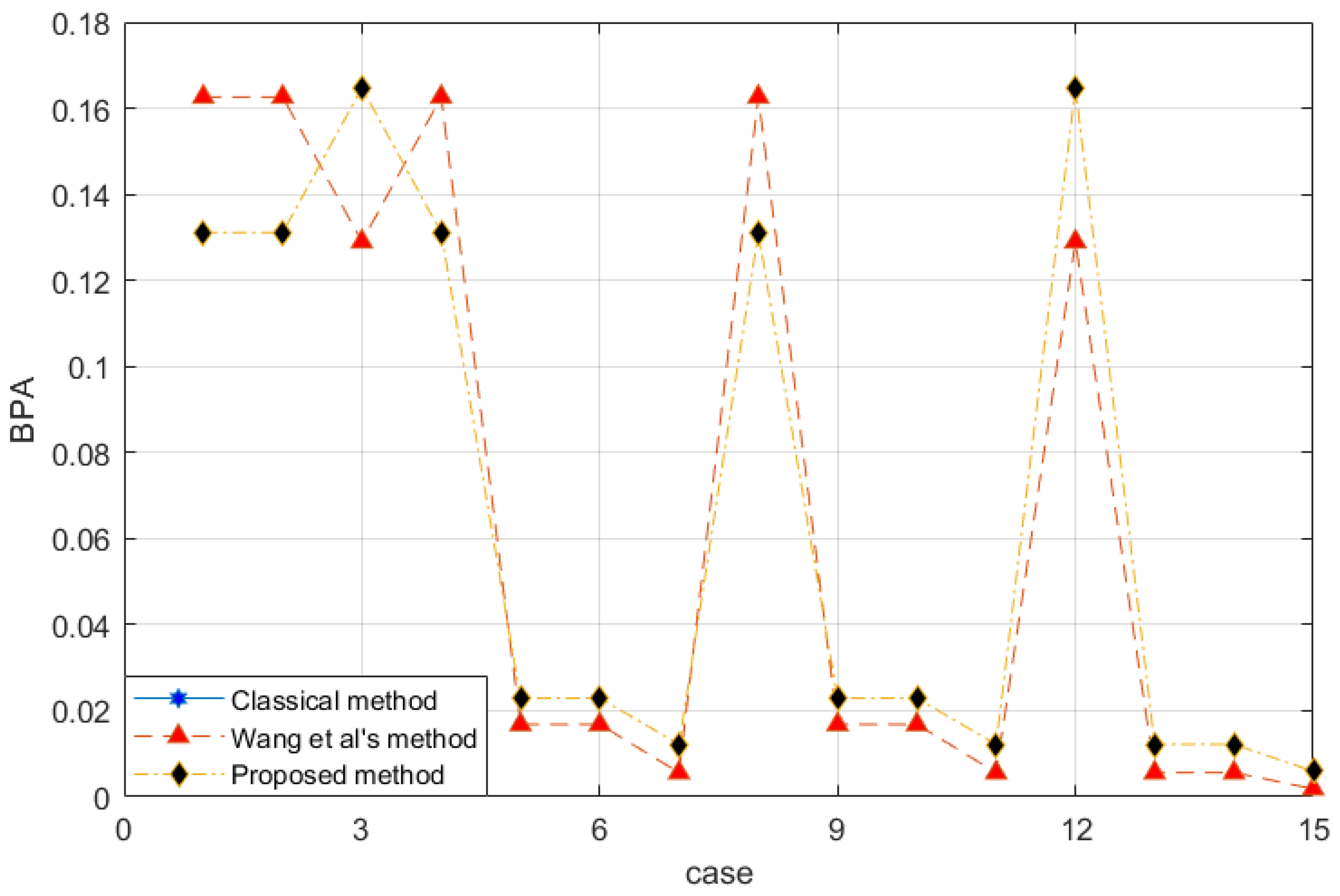
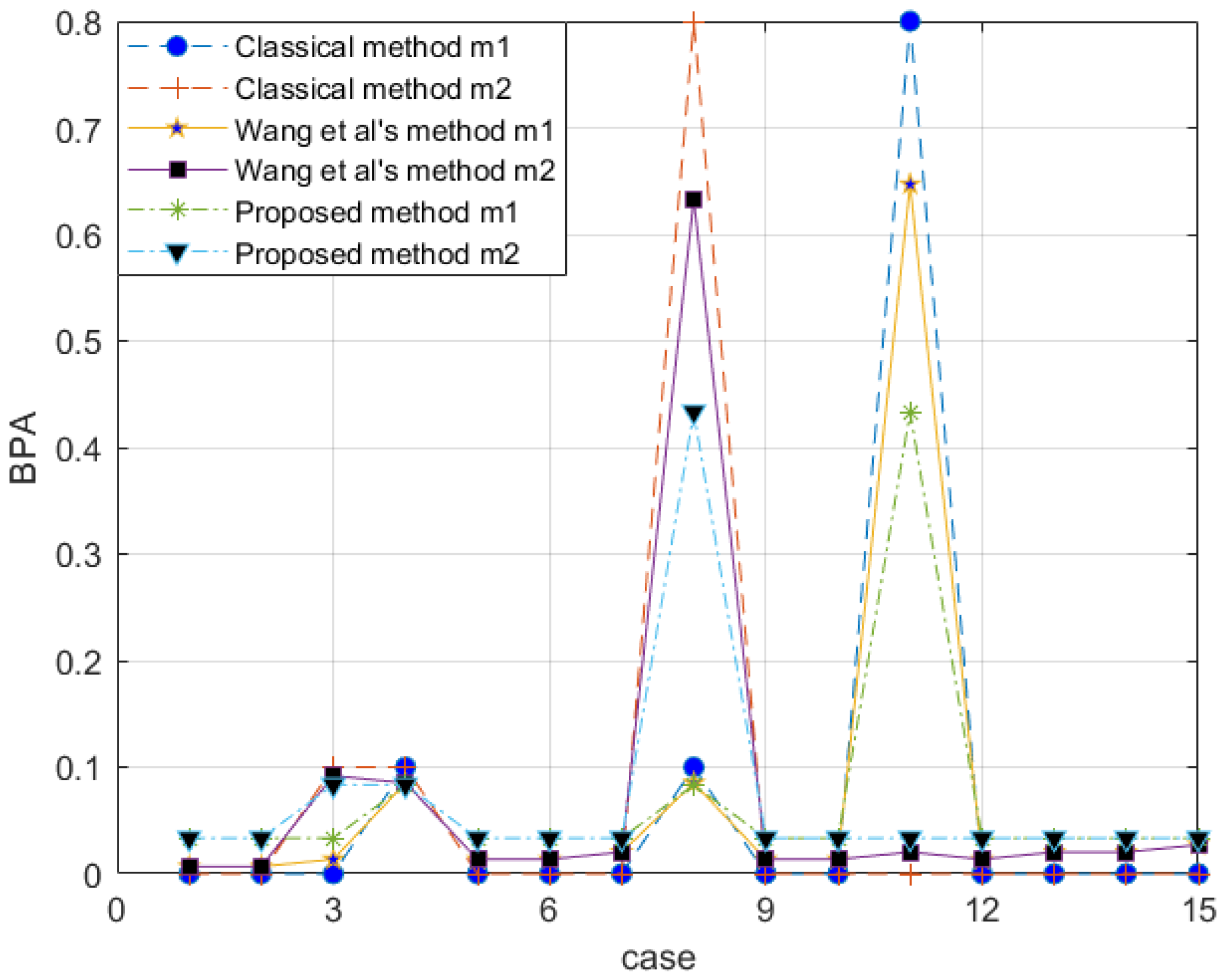
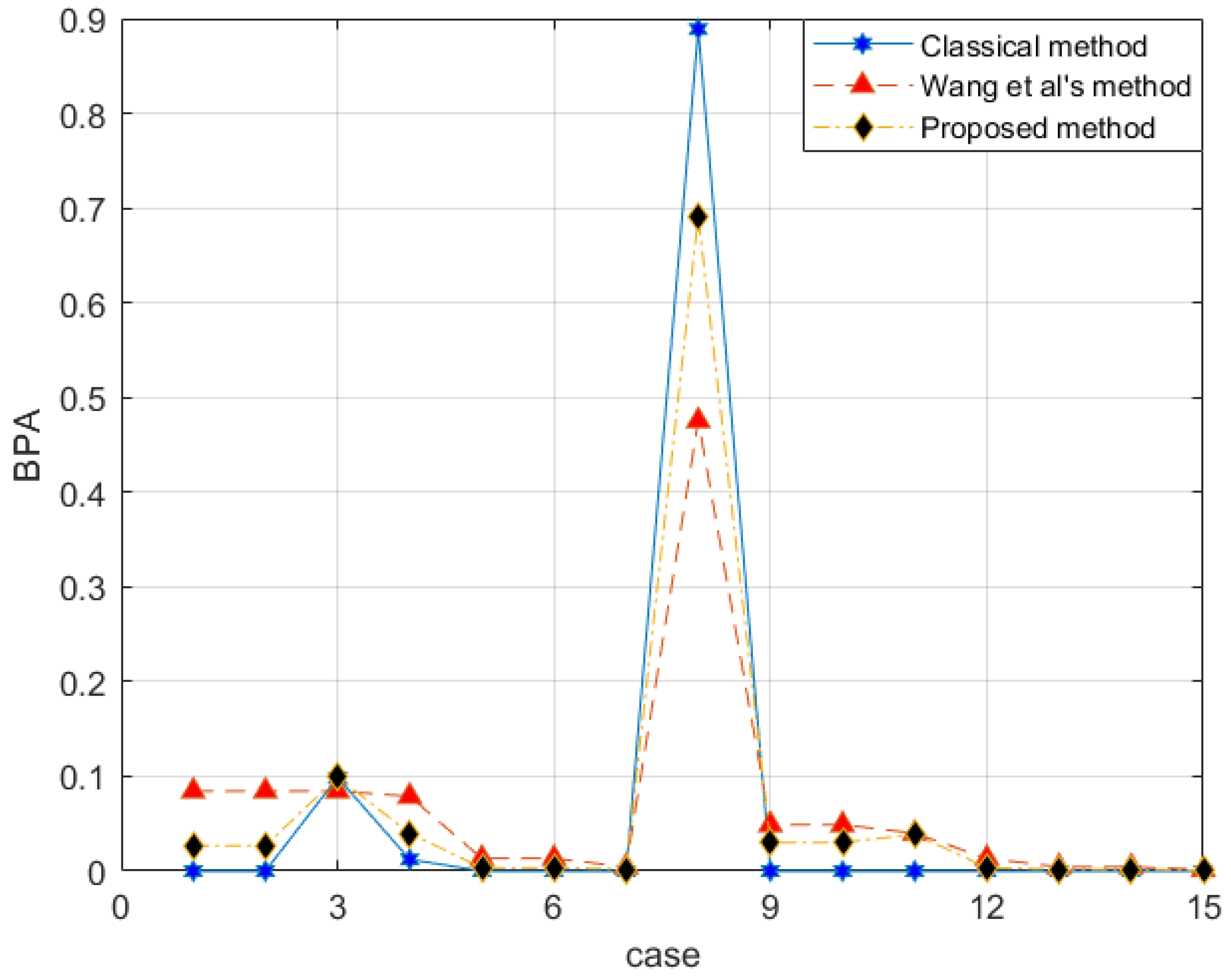
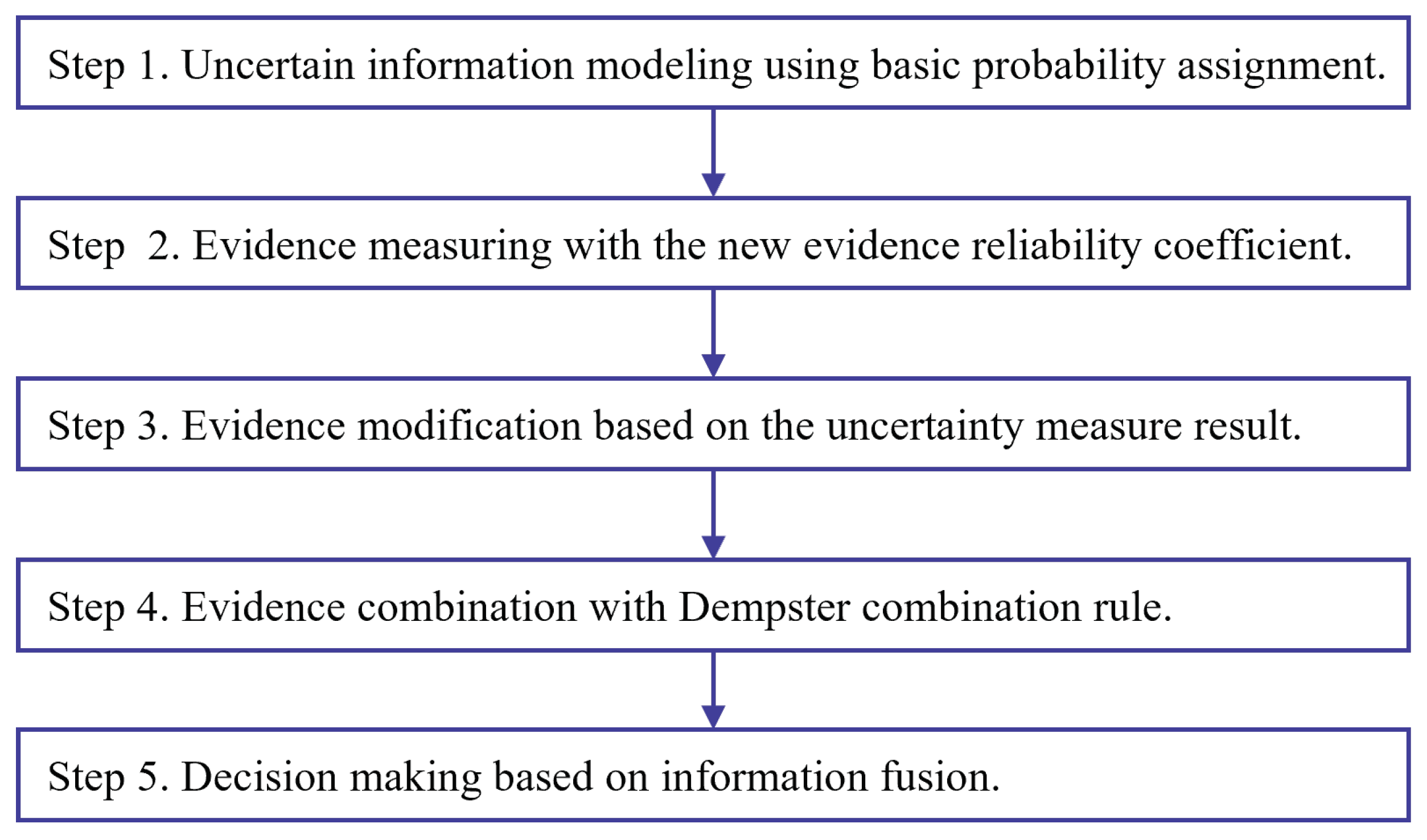

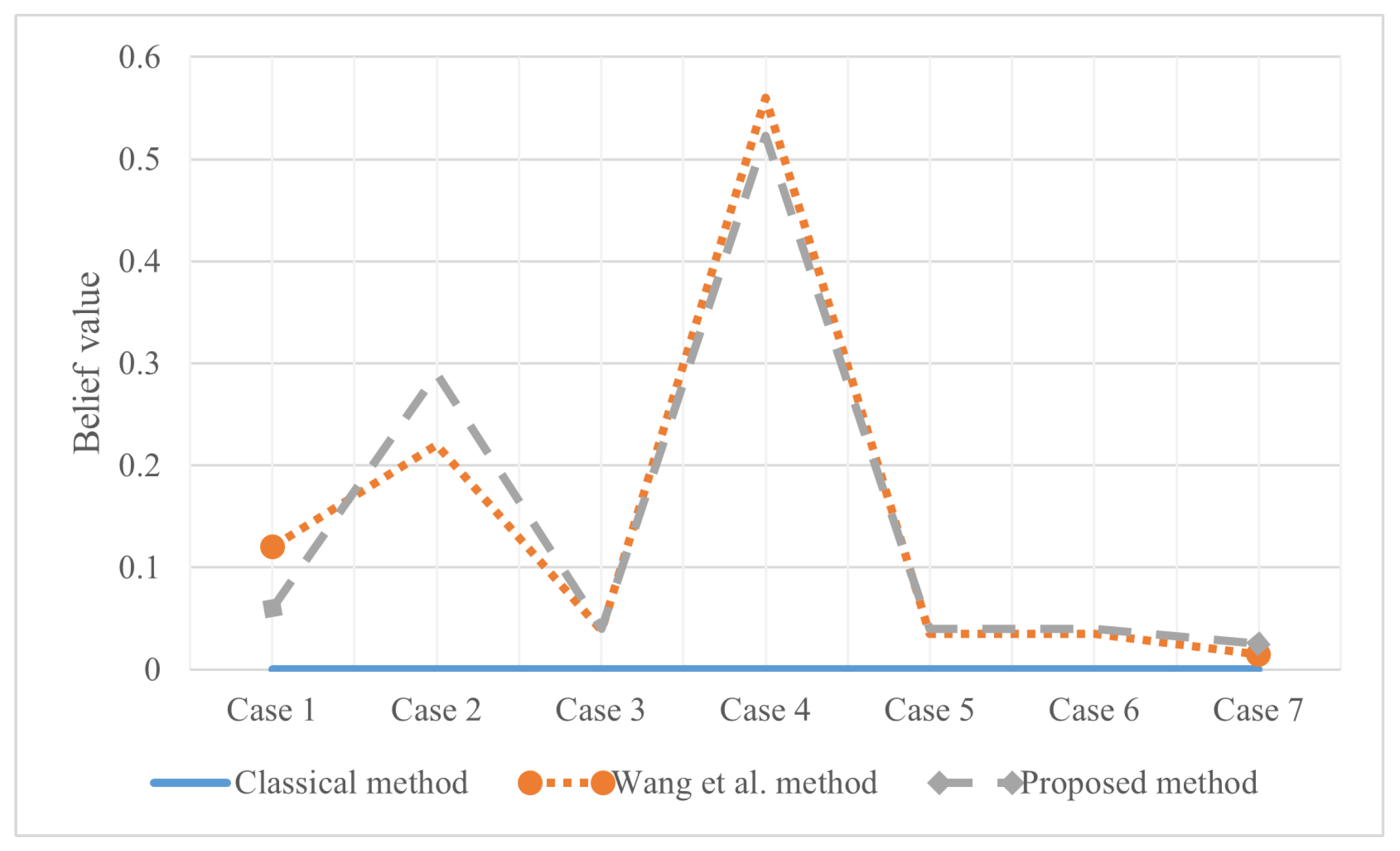
| Uncertainty Measure | Definition | Evidence Element |
|---|---|---|
| Hohle’s confusion measure [56] | m, | |
| Yager’s dissonance measure [57] | m, | |
| Dubois and Prade’s weighted Hartley entropy [58] | m, | |
| Klir and Ramer’s discord measure [59] | m, | |
| Klir and Parviz’s strife measure [60] | m, | |
| George and Pal’s total conflict measure [61] | m, | |
| Jousselme et al. measure [62] | m, | |
| Deng entropy [63] | m, | |
| Jirousek et al. measure [64] | m, | |
| Pan et al. measure [65] | m, , | |
| Proposed measure | m, |
| Evidence | ||||||||
| 0.0156 | 0.0156 | 0.0156 | 0.0156 | 0.5313 | 0.0313 | 0.0313 | 0.3130 | |
| Evidence | ||||||||
| 0.0313 | 0.0313 | 0.0469 | 0.0469 | 0.0469 | 0.0469 | 0.0625 |
| Attribute | Real Banknotes | Counterfeit Banknotes |
|---|---|---|
| Variance | (−7.0421, −1.7931, 2.3917) | (−4.2859, 2.5531, 6.8248) |
| Skewness | (−13.7731, 0.1821, 9.6014) | (−6.9321, 5.6688, 12.9516) |
| Curvature | (−5.2861, 0.2752, 17.9274) | (−4.9417, 0.7006, 8.8294) |
| Image Entropy | (−7.5887, −0.6629, 2.1353) | (−8.5482, −0.5524, 2.4495) |
| Varience | Skewness | Curvature | Image Entropy | |
|---|---|---|---|---|
| 0.6607 | 0.7696 | 0.6606 | 0.4474 | |
| 0.3200 | 0.2112 | 0.3106 | 0.4835 | |
| 0.0385 | 0.0385 | 0.0575 | 0.1382 |
| Attribute | Setosa | Versicolour | Virginica |
|---|---|---|---|
| Sepal length | (4.3, 5.0, 5.8) | (4.9, 6.0, 7.0) | (4.9, 6.5, 7.9) |
| Sepal width | (2.3, 3.4, 4.4) | (2.0, 2.8, 3.4) | (2.2, 3.0, 3.8) |
| Petal length | (1.0, 1.5, 1.9) | (3.3, 4.4, 5.1) | (4.5, 5.6, 6.9) |
| Petal width | (0.1, 0.2, 0.6) | (1.0, 1.3, 1.8) | (1.4, 2.0, 2.5) |
| Attribute | |||||||
|---|---|---|---|---|---|---|---|
| Sepal length | 0.0146 | 0.4643 | 0.0293 | 0.3893 | 0.0293 | 0.0293 | 0.0439 |
| Sepal width | 0.1548 | 0.3887 | 0.0423 | 0.2662 | 0.0423 | 0.0423 | 0.0634 |
| Petal length | 0.0343 | 0.0343 | 0.0687 | 0.6223 | 0.0687 | 0.0687 | 0.1030 |
| Petal width | 0.0211 | 0.7674 | 0.0423 | 0.0211 | 0.0423 | 0.0423 | 0.0634 |
Disclaimer/Publisher’s Note: The statements, opinions and data contained in all publications are solely those of the individual author(s) and contributor(s) and not of MDPI and/or the editor(s). MDPI and/or the editor(s) disclaim responsibility for any injury to people or property resulting from any ideas, methods, instructions or products referred to in the content. |
© 2023 by the authors. Licensee MDPI, Basel, Switzerland. This article is an open access article distributed under the terms and conditions of the Creative Commons Attribution (CC BY) license (https://creativecommons.org/licenses/by/4.0/).
Share and Cite
Tang, Y.; Wu, S.; Zhou, Y.; Huang, Y.; Zhou, D. A New Reliability Coefficient Using Betting Commitment Evidence Distance in Dempster–Shafer Evidence Theory for Uncertain Information Fusion. Entropy 2023, 25, 462. https://doi.org/10.3390/e25030462
Tang Y, Wu S, Zhou Y, Huang Y, Zhou D. A New Reliability Coefficient Using Betting Commitment Evidence Distance in Dempster–Shafer Evidence Theory for Uncertain Information Fusion. Entropy. 2023; 25(3):462. https://doi.org/10.3390/e25030462
Chicago/Turabian StyleTang, Yongchuan, Shuaihong Wu, Ying Zhou, Yubo Huang, and Deyun Zhou. 2023. "A New Reliability Coefficient Using Betting Commitment Evidence Distance in Dempster–Shafer Evidence Theory for Uncertain Information Fusion" Entropy 25, no. 3: 462. https://doi.org/10.3390/e25030462
APA StyleTang, Y., Wu, S., Zhou, Y., Huang, Y., & Zhou, D. (2023). A New Reliability Coefficient Using Betting Commitment Evidence Distance in Dempster–Shafer Evidence Theory for Uncertain Information Fusion. Entropy, 25(3), 462. https://doi.org/10.3390/e25030462






